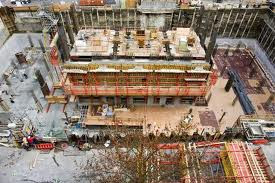 Being left to swing within the wind usually isn't a good thing.
Being left to swing within the wind usually isn't a good thing.That's especially true of cranes -- depending on your point of view.
Parr Financial Oregon, the investment firm that owns the Nordstrom building in downtown Portland, filed a nuisance and trespass complaint this week in Multnomah County Circuit Court against neighboring Fox Tower-owner TMT Development and, ultimately, its big orange crane.
The crane, the lawsuit alleges, has been sitting fairly idle over the past year at Southwest Park Avenue and Yamhill Street since the recession stalled Tom Moyer's office tower project known as Park Avenue West. But more bothersome, it seems, than the gaping hole in the ground is the crane's tendency to blow over the Nordstrom building whenever there's a good gust of wind.
Representatives of Parr Financial declined to remark on the case, and Vanessa Sturgeon, president of TMT Development, did not return a call seeking comment.
The suit contends the crane's arm -- or jib as it's also known as -- intrudes upon Nordstrom's airspace and it is asking a legal court for damages, costs and a ruling that forces TMT to operate and maintain the crane in such a way that it no longer trespasses.
Interestingly, experts say, that swing is what makes a tower crane safer.
"When there's no operator in the seat, tower cranes have to weather vane, which means swing in the wind," said Eddie Zawislak, a power crane salesman for the Coast Crane Co. of Seattle. Swinging, he said, allows the crane to withstand more wind and minimize the possibility it will tip over. When left to move freely, most tower cranes can withstand winds of as much as 100 mph. Still, he said, a couple of fatal crane accidents in recent years may have fueled fears. In 2006, there was a fatal accident in a suburb of Seattle, where Nordstrom is based. The Bellevue crane collapse was ultimately blamed on faulty design and installment.
"When people see a tower crane, they don't want it falling over on their building," he said. "It's more of a safety concern by people who don't understand tower crane engineering."
In other trespassing crane cases, industry experts say, the existing landowner is usually given a certain amount of airspace ownership -- often the distance between the current building's height and the height that building codes would allow new construction to go on that lot.
That's where cranes can't go. Unless, of course, there's a settlement, which Zawislak yet others say there often is. That could entail developing a rental agreement for the crane's in time that airspace.
0 comments:
Post a Comment